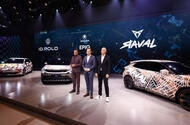Why Has Volkswagen’s Journey Toward Affordable EVs Been So Challenging?
If you’ve been following the electric car revolution, you’ve probably noticed Volkswagen’s name popping up again and again. But the road to a truly affordable electric Volkswagen—one that feels as accessible as the classic Polo or Golf—hasn’t been smooth. So, what’s been holding them back?
Let’s rewind to 2021. That year, at the Munich Motor Show, Volkswagen unveiled the ID Life concept. It was bold, boxy, and a clear signal that VW wanted to break into the sub-£22,000 (€25,000) EV market. The idea was to use a new MEB Entry platform, making it possible for Volkswagen, Cupra, and Skoda to offer electric cars that didn’t break the bank.
But here’s the thing: the ID Life didn’t land well. Its styling was a sharp left turn from what people expected from VW—neither a nod to their beloved classics nor a natural evolution of their newer ID models. The feedback was lukewarm at best, and that led to a shake-up at the top. Thomas Schäfer took over as CEO, and Andreas Mindt stepped in as design chief. Their mission? Bring back the magic that made Volkswagen a household name.
How Did Volkswagen Respond to Early Criticism of Its Entry-Level EVs?
After the ID Life’s rocky reception, Volkswagen knew it had to pivot. Schäfer and Mindt started looking backward to move forward, drawing inspiration from the brand’s rich heritage. Schäfer talked openly about making Volkswagen a “love brand” again—something people feel genuinely connected to, not just a badge on a car.
This shift in mindset led to the creation of the ID 2all concept. Unlike the ID Life, the ID 2all felt unmistakably Volkswagen. It was still based on the same platform, but the design was more familiar, more inviting. The response? Much warmer. People saw echoes of the classic Polo and Golf, and suddenly, the idea of an affordable VW EV didn’t seem so far-fetched.
The momentum kept building. At the next Munich show, VW rolled out the ID GTI concept—a sportier, even more heritage-driven take on the ID 2all. Again, the crowd loved it. The lesson was clear: Volkswagen’s strength lies in blending new tech with the comfort of tradition.
What’s Actually Changed Behind the Scenes at Volkswagen?
It’s not just about new faces at the top or retro-inspired designs. Volkswagen has been quietly reorganizing how it works. The company created a new Core division, bringing together Volkswagen, Cupra, Skoda, and Volkswagen Commercial Vehicles. Instead of each brand working in its own silo, they’re collaborating more closely, especially on the new ID Entry project.
This teamwork has helped speed up development and share costs—a crucial move when you’re trying to make EVs affordable. It’s also allowed each brand to put its own spin on the shared platform, so buyers get more choice without the price tag creeping up.
Are We Finally Close to Seeing a Truly Affordable Volkswagen EV?
Fast forward to 2025, and things are looking promising. At the latest Munich Motor Show, Volkswagen showed off near-production versions of what’s now called the ID Polo and ID Polo GTI, plus the Cupra Raval and Skoda Epiq. These cars are all built on the same bones as the original ID Life concept, but with smarter design, better tech, and—crucially—names and looks that resonate with buyers.
There was even a sneak peek at the upcoming ID Cross, which will join the lineup next year. The takeaway? Volkswagen’s four-year quest to deliver a £22,000 EV is finally nearing reality.
How Is Volkswagen Positioning Itself Against Fierce Competition?
The affordable EV race is heating up, especially with Chinese automakers flooding the market with low-cost options. Volkswagen’s answer isn’t just to match them on price but to offer something they can’t: decades of brand trust and a design language people already love.
It’s a strategy that’s working for others, too. Renault, for example, has found success with its new 5 and 4 models by mixing fresh EV tech with retro styling. For Volkswagen, leaning into its heritage isn’t just about nostalgia—it’s about standing out in a crowded field and reminding buyers why they fell in love with the brand in the first place.
What Can We Learn From Volkswagen’s Rocky Road to Affordable EVs?
Volkswagen’s journey from the ID Life to the soon-to-arrive ID Polo hasn’t been a straight line. There have been missteps, management changes, and plenty of lessons learned. But if there’s one thing this story shows, it’s that innovation doesn’t mean forgetting your roots.
By listening to feedback, embracing collaboration, and staying true to what made the brand special, Volkswagen is finally on the cusp of delivering an electric car that’s both affordable and unmistakably VW. For drivers who want to go electric without giving up the familiarity and warmth of a classic Volkswagen, that’s big news.
The outcome? A new generation of EVs that feel like old friends—just with a lot less tailpipe emissions. And for a company with Volkswagen’s legacy, that’s a future worth getting excited about.

